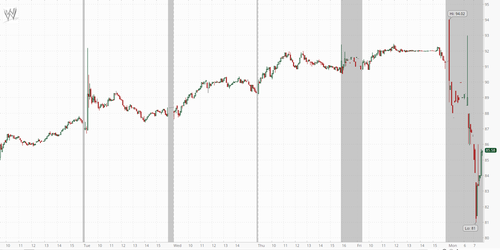Paris. Such a romantic city.
Sip cafe at a sidewalk bistro, while you take in the wafting smell of burning rubber from the street fires.
Take a picture with the Eiffel Tower, as you dodge incoming tear-gas canisters.
Enjoy the ambiance as you stroll the alleys between 5,600 metric tons of garbage currently rotting on the sidewalks.
See, the sanitation workers’ union is one of several currently on strike in Paris.
They and over a million protesters have lit fires in the streets, destroyed property, and sparred with riot police over the past weeks.
All in an effort to stop the government from raising the retirement age from 62 to 64 by 2030. (Or from 57 to 59 for professions considered dangerous, such as garbage collectors.)
Like essentially all Western countries, France’s population is aging. And the retirement system depends on more workers paying into the system than retirees collecting.
In 1950, four French workers were paying for just one retired French pensioner.
Today, the ratio is less than two workers for each retiree— and by 2040 it could be about 1:1.
Now, it’s understandable that people are angry over broken promises.
But the public refuses to understand or accept basic financial realities.
They exist in a world where all this stuff is free, and they simply shouldn’t have to worry about things like saving for retirement.
And of course, France is far from unique. It is simply a mild preview of the social chaos that is coming to the US…
Three days ago (last Friday March 31st) the Board of Trustees for Social Security released its annual report.
According to the report, Social Security has been paying out more than it takes in since 2021, and “Social Security’s total cost is projected to be higher than its total income in 2023 and all later years.”
And at that rate, “reserves become depleted in 2033, one year earlier than projected in last year’s report.”
So the situation is actually getting worse.
Keep in mind these aren’t some random fringe economists writing this. The Board of Trustees of Social Security include, for example, US Treasury Secretary Janet Yellen.
So what happens when Social Security’s trust funds run out of money?
Well, the program won’t disappear entirely; there will still be incoming payroll tax revenue to partially fund the program (FICA taxes that are paid by workers).
But just like the situation in France, there simply aren’t enough workers in the system to keep paying full benefits to the program’s 51+ million retirees.
This means that, even factoring in payroll tax revenue, Social Security recipients are going to have to take an enormous cut in their monthly benefit of around 25%.
And that might be wildly optimistic; in their annual report the Social Security lists the key assumptions of their projections… and those assumptions look like they could be grossly incorrect.
For example, the agency assumes that inflation in the US will return to 2%-3%, and basically stay there forever. Fat chance.
They also assume that the US fertility rate (which is a critical indication of the number of future taxpayers) will be 2.0; this is another outrageously bad assumption, given that the US fertility rate hasn’t consistently been above 2.0 since the late 1960s!
The trustees’ are clearly making bad assumptions… so even when they say the trust fund will run dry in 2023, but that they’ll still be able to make roughly 3/4 of the payments, the reality is likely much, much worse.
But right now, with all these obvious problems rapidly approaching, politicians are promising voters that they WON’T touch Social Security.
Even the ones talking about balancing the budget vow not to touch Social Security…
(To balance the budget without touching the sacred cows of Social Security, Medicare, and Defense would require cutting 85% of ALL other federal spending.)
Of course, reality is reality, and places like France show us the inevitable outcome:
- The retirement age will go up
- Benefits will be cut substantially
- Payroll taxes will increase
We might also expect the same, or worse, reaction as in France— massive protests, strikes, riots, property destruction, and social chaos.
And all that will do nothing.
Because there are really two institutions which Americans could realistically expect to solve this problem:
One, the US government, currently saddled with $31.5 trillion of debt and rapidly increasing, with a total net worth (assets versus liabilities) of NEGATIVE $34 trillion.
Two, the Federal Reserve, which last year reported ‘unrealized losses’ of more than $330 billion against just $42 billion in capital, making it completely and totally insolvent.
So there are really only two plays left to make…
The US government could raise taxes to cover the gap.
The Federal Reserve could print money to cover the gap, creating massive inflation.
Without responsible leadership willing to make tough decisions, this is their default option.
There are a few takeaways here.
1. Prepare to fund a portion of your own retirement.
Between inflation and benefit cuts, you simply cannot rely on the promises the government has made to you about your retirement.
It’s probably not going away entirely, but you should consider Social Security as a supplement to your retirement, and not the primary source. You certainly won’t be any worse off if by some miracle Social Security manages to pay the full benefits.
2. Prepare for a future with higher taxes.
And take every legal step at your disposal to reduce what you owe.
3. Prepare for a future with higher inflation.
Again, the government’s inevitable solution is to go deeper into debt, and print the money to fund it. As we’ve already seen, more money printing means more inflation.
That doesn’t necessarily mean inflation will be at 10-15% levels for years to come. But it probably won’t be the 2% average we’ve gotten used to over the past two decades.
The good news is you can control your own fate by having your own retirement funds, which puts you in the drivers street.
And at the same time, you can lower your taxable income significantly by, for example, contributing to a Traditional 401(k) retirement account.
As of 2023, you can contribute up to $22,500 per year, or $30,000 per year if you’re over 50.
For those who are self employed, earn money through a side businesses, or own a business without any employes, using a Solo 401(k) is even more beneficial.
In 2023, the tax-free limit for contributions rises to $66,000 (or $73,500 for those age 50 and older) because you can make both the employer and employee contributions.
A self-directed Solo 401(k) also provides a wider range of investment options such as real estate, foreign investments, private equity, and more.
And this barely even scratches the surface of the options you have available to shore up your retirement, beat inflation, and legally reduce your tax rate.
You don’t have to protest, or vote harder. You simply have to understand the magnitude of the problem, and use the tools at your disposal to fix it.

from Sovereign Man https://ift.tt/6WenmcR
via IFTTT





